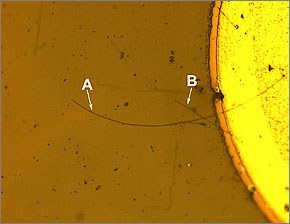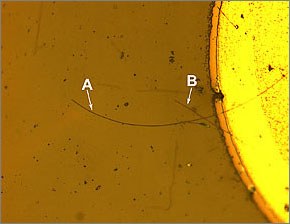New Fabrication Technique Yields Nanoscale UV LEDs
Researchers at the National Institute of Standards and Technology (NIST), in collaboration with scientists from the University of Maryland and Howard University, have developed a technique to create tiny, highly efficient light-emitting diodes (LEDs) from nanowires.
As described in a recent paper,* the fabricated LEDs emit ultraviolet light—a key wavelength range required for many light-based nanotechnologies, including data storage—and the assembly technique is well-suited for scaling to commercial production.
Light-based nanoscale devices, such as LEDs, could be important building blocks for a new generation of ultracompact, inexpensive technologies, including sensors and optical communications devices. Ultraviolet LEDs are particularly important for data-storage and biological sensing devices, such as detectors for airborne pathogens. Nanowires made of a particular class of semiconductors that includes aluminum nitride, gallium nitride and indium nitride are the most promising candidates for nanoscale LEDs. But, says NIST researcher Abhishek Motayed, “The current nanowire LEDs are created using tedious nanowire manipulation methods and one-by-one fabrication techniques, which makes them unsuitable for commercial realization.”
The NIST team used batch fabrication techniques, such as photolithography (printing a pattern into a material using light, similar to photography), wet etching and metal deposition. They aligned the nanowires using an electric field, eliminating the delicate and time-consuming task of placing each nanowire separately.
A key feature of the new nanowire LEDs is that they are made from a single compound, gallium nitride (GaN). Each LED consists of an “n-type” GaN nanowire placed on the surface of a “p-type” GaN thin film. “N-type” and “p-type” refer to semiconductors with, respectively, an abundance of electrons and an abundance of positively charged electron vacancies called holes. P-n junctions made from the same basic compound yield more efficient LEDs than those made with different compounds, and so can operate at lower power.
When the proper voltage is applied to the junction, it emits light with a peak wavelength of 365 nanometers, which falls squarely in the ultraviolet range. The group produced and tested more than 40 of these LEDs; all showed very similar emission properties. They also displayed excellent thermal stability—withstanding temperatures up to 750 degrees Celsius—and operational stability, showing no signs of deterioration even after two continuous hours of operation at room temperature. These properties indicate that this LED production method yields reliable, stable devices. The researchers say their method could be used to fabricate other nanowire structures as well as applications requiring a large area of nanoscale light sources.
*A. Motayed, A. Davydov, M. He, S. N. Mohammed and J. Melngailis. 365 nm operation of n-nanowire/p-gallium nitride homojunction light emitting diodes. Applied Physics Letters 90, 183120 (2007)
Note: Origimal story from a news release issued by National Institute of Standards and Technology.



